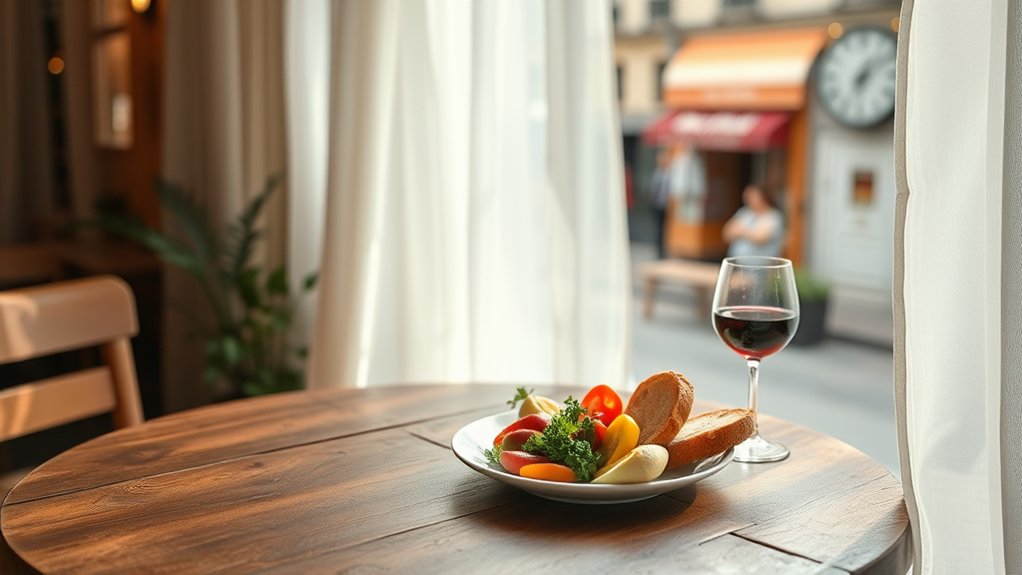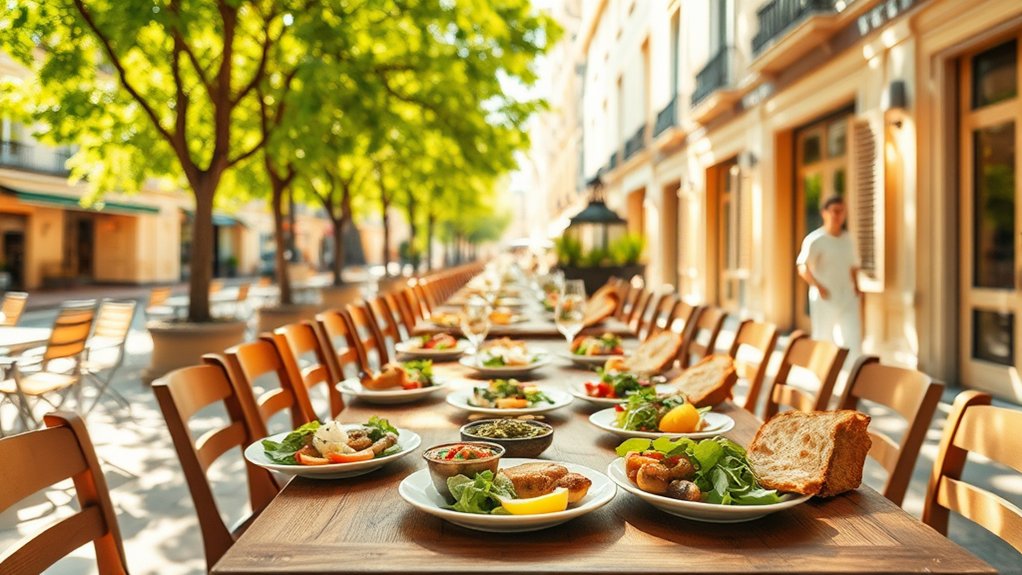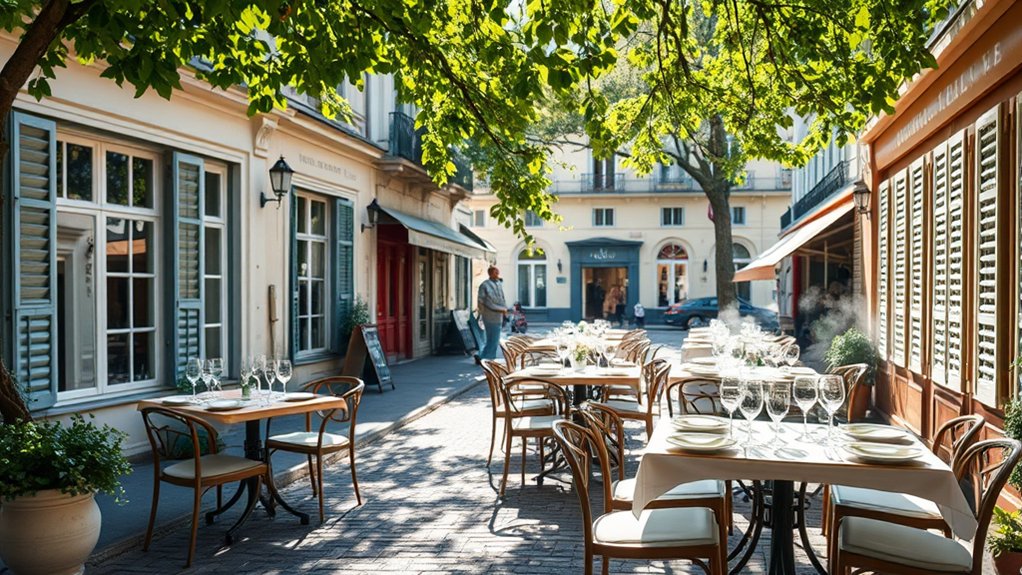French Work Hours: Why Shops Close During Lunch

In France, shops often close during lunch to celebrate the cultural importance of this meal! Employees value a break to unwind and socialize, reflecting on the communal nature of dining. Typically, lunch breaks happen between 12 PM and 2 PM, with many restaurants offering a hearty meal for around €15. It's a great time to experience local flavors at nearby cafés. Curious about other dining customs and tips? There's plenty more to investigate about French mealtime traditions!
Lunch Break Etiquette

In France, lunch breaks are more than just a meal; they are a cultural cornerstone that fosters social connections. With average breaks lasting around an hour, employees are encouraged to step away from their desks to enjoy their food and company without distractions. This practice not merely respects local customs but can also boost productivity by creating a more relaxed and engaged work environment. Lunch is considered the most important meal of the day, emphasizing the significance of taking the time to savor this midday pause.
Cultural Importance of Lunch
Lunch in France embodies a delightful blend of tradition, social connection, and culinary enjoyment! This cherished meal is not just about food; it's a time for communal meals that strengthen social bonds among colleagues and friends.
With a structured approach, French lunches often feature multiple courses, allowing diners to savor each bite while engaging in meaningful conversation. Fixed lunch breaks, typically lasting up to two hours, encourage relaxation and discourage desk eating. This etiquette fosters a sense of togetherness, making lunchtime a crucial part of daily life. Additionally, French laws prohibit eating at desks to promote well-being and idea exchange, reinforcing the importance of taking a proper lunch break. The emphasis on savoring meals also reflects the French cultural belief in enjoying life over rushing through it.
Additionally, the French take pride in their culinary traditions, with meals served at set times, reinforcing a cultural respect for the ritualistic nature of dining. Embracing these practices enriches the dining experience!
Legal Work Hour Regulations
French work hour regulations are designed with both productivity and well-being in mind! The law guarantees that employees enjoy vital breaks, with specific legal obligations regarding lunch hours. For instance, workers must take a minimum of 30 minutes after 4.5 hours of work, which is a lovely way to recharge. This is reflective of the French lunchbreak law, emphasizing the importance of changing pace and scenery during breaks.
These breaks are typically unpaid, but if tasks are performed, they might count as working time. Employees also have the right to a 35-hour workweek, limiting daily hours to 10. This focus on employee rights fosters a balanced work-life environment.
Many companies even provide designated dining areas, reinforcing the importance of a proper lunch break. So, embracing this culture can lead to a more fulfilling work experience!
Impact on Productivity Levels
While many might see a lunch break as just a pause in the workday, it plays a vital role in boosting productivity levels!
In France, the tradition of a long lunch not merely supports workplace culture but also enhances employee satisfaction. These breaks allow individuals to relax, socialize, and recharge, leading to significant productivity benefits. Furthermore, 96% of employees with access to a company restaurant use it frequently, highlighting its importance in fostering a positive workplace environment. Embracing family bonding time during lunch can also enhance relationships among coworkers, creating a more collaborative atmosphere.
When employees step away from their desks, they return with heightened focus and creativity. Company restaurants often provide healthy, diverse meals, catering to various tastes, which encourages team bonding.
Additionally, taking regular breaks prevents burnout, ultimately fostering a more efficient work environment.
Cultural Significance of Lunch Breaks
In the bustling atmosphere of a typical French workday, the midday break transforms into a cherished ritual rather than just a meal. This cultural significance of lunch breaks reflects deep-rooted traditions, encouraging social gatherings and camaraderie among colleagues.
- Lunch is typically served at noon or 1 PM.
- Long breaks, often exceeding an hour, allow for relaxation.
- Eating at desks is legally prohibited to foster social interaction.
- Company restaurants enhance workplace dynamics and relationships. Moreover, mealtime customs in France emphasize the importance of enjoying meals together, reinforcing relationships among colleagues.
These cultural rituals not only highlight the importance of food but also create a shared experience that strengthens community bonds. In France, lunch is much more than nourishment; it's an opportunity for connection, laughter, and rejuvenation—a delightful pause in the day's hustle! Notably, the standard workweek is 35 hours, which further emphasizes the value placed on long lunches.
Lunch Hour Closure Overview
As lunchtime approaches, many shops and businesses in France embrace a time-honored tradition of closing their doors to observe a midday break. This practice, steeped in local customs, varies across regions. Smaller, owner-operated shops often shut down, allowing owners personal time, while urban areas adapt to modern consumer needs. Tourists might find these closures surprising, requiring adjustments to their schedules. This authentic cultural experience allows visitors to appreciate the leisurely pace of French life.
| Type of Shop | Typical Closure Hours |
|---|---|
| Small Shops | 12:00 PM – 2:00 PM |
| Larger Stores | Usually Open |
| Rural Establishments | 12:00 PM – 3:00 PM |
Understanding these nuances enhances the French experience, blending relaxation with cultural appreciation. Embrace the charm of leisurely lunches!
Embrace the Long Lunch Tradition

In France, the long lunch break is more than just a meal; it's a cherished tradition that enhances both social and work life. Understanding how to embrace this cultural norm can lead to meaningful connections and enriched well-being. Here are some key points to consider when navigating the French lunch experience:
- Timing is Key: Lunch typically starts around noon or 1 pm, so plan accordingly!
- Avoid Rush: Take your time and savor each course; rushing through a meal is a common mistake.
- Engage with Others: Use this time to connect with colleagues; social interaction is part of the experience.
- Explore Local Options: Seek out nearby bistros or company restaurants that offer affordable lunch menus to make the most of your break.
- Culinary Traditions: Embracing the long lunch allows you to appreciate France's culinary scene, where meals are crafted with precision and local ingredients.
What You Need to Know
While many cultures see lunch as just a quick refueling stop, the French embrace it as a cherished tradition that can last up to an hour or more!
This leisurely approach to lunch is not just about food; it shapes social interactions and strengthens bonds. Understanding these lunch customs will enhance any dining experience in France.
- Lunch typically occurs between 12:00 pm and 2:00 pm.
- Restaurants often close during this time, so plan accordingly.
- Expect a minimum of 20 minutes for lunch breaks at work.
- Take advantage of communal spaces in offices to enjoy meals with colleagues.
Embracing the long lunch tradition allows for relaxation and connection, making it a delightful part of French culture! Additionally, the work-life balance in France emphasizes the importance of taking time for personal well-being and meaningful interactions.
Common Mistakes to Avoid
What strategies can one employ to fully embrace the long lunch tradition in France?
To truly savor this cultural experience, it's crucial to avoid common pitfalls. Embracing the lunch duration is key to enjoying meaningful dining habits. Here are some helpful tips:
- Plan Ahead: Know when restaurants close for lunch to avoid disappointment.
- Slow Down: Resist the urge to rush; this meal is about enjoyment, not just nourishment.
- Engage with Locals: Strike up conversations or ask for recommendations—it's part of the charm!
- Explore Varied Menus: Try regional specialties to enhance your culinary experience.
- Savor Seasonal Ingredients: Choosing dishes that feature seasonal ingredients ensures a fresh and authentic taste that reflects the local culture.
Pro Tips
Embracing the long lunch tradition in France can be a delightful experience filled with flavor and connection.
This cherished practice fosters social bonding, allowing individuals to savor local culinary delights in a relaxed atmosphere.
Here are some pro tips to enhance your lunchtime experience:
- Schedule regular social lunches to strengthen relationships and team dynamics.
- Discover local restaurants or company cafeterias for unique culinary experiences.
- Take the time to enjoy meals slowly, maximizing relaxation and connection.
- Encourage breaks that rejuvenate and lead to greater productivity.
Dining Reservations Recommended
Dining reservations are highly recommended when exploring the vibrant culinary scene in France.
With Saturdays seeing a staggering 85% more reservations than the average day, planning ahead can enhance the dining experience!
Whether it's a leisurely lunch or a special dinner, securing a table guarantees a delightful meal without the hassle of waiting. Additionally, many dining experiences in France can be enriched by enjoying traditional folk music that reflects the cultural heritage of the region.
Costs and Budget
Navigating the costs of dining in France can feel like a delightful adventure! With careful meal planning, visitors can enjoy a variety of experiences while managing their dining budget.
| Meal Type | Average Cost |
|---|---|
| Lunch | €15 |
| Dinner | €100+ |
| Street Food | €5-8 |
| Local Cafés | €10-20 |
Opting for local cafés or street food can keep expenses low, allowing one to savor the culinary delights without breaking the bank. Additionally, be mindful of reservation fees, which can add to meal costs. Taking these factors into account can enhance the dining experience, making every meal a cherished memory! Planning around school holidays can also help manage dining expenses, as many restaurants offer special menus during peak times.
Timing and Planning
When planning a meal in France, it's vital to consider the unique timing of lunch hours, as they can significantly impact dining options. Many restaurants serve lunch from 12 PM to 2:30 PM, so timing strategies become fundamental.
Here are some helpful planning tips:
- Make reservations ahead of time to secure a table.
- Be aware that shops often close between 12 PM and 2 PM.
- Investigate menus outside main dining hours for simpler dishes.
- Remember that lunch prices are generally lower than dinner.
- Additionally, understanding French business hours can further enhance your planning and dining experience.
Understanding these nuances guarantees a more enjoyable experience, allowing visitors to savor leisurely meals while embracing the French culture.
With thoughtful planning, one can traverse this charming landscape of lunch hour traditions seamlessly!
Additional Resources
How can one guarantee a delightful dining experience in France? Embracing the local dining trends and reservation habits can make all the difference.
With many restaurants bustling during peak hours, securing a reservation is often wise.
- Always consider booking directly through the restaurant's website.
- Investigate platforms like La Fourchette/TheFork for easy online reservations.
- Popular dining times are typically around 6:00 p.m. and 7:00 p.m.
- Seasonal variations can significantly affect restaurant hours and availability.
While only 12% of diners consistently make reservations, those who do enjoy a smoother experience.
Weather-Related Dining Preferences
Weather plays a significant role in shaping dining preferences, influencing everything from menu changes to outdoor seating trends.
When the sun shines and temperatures are mild, diners often flock to patios, while rain can lead to a spike in indoor reservations.
Understanding these patterns can help restaurants adjust their offerings and marketing strategies efficiently!
Seasonal Menu Changes
As the seasons change, so too do the dining preferences of many food lovers! Restaurants adapt their menus to embrace seasonal ingredients, reflecting the vibrant flavors that each time of year brings.
In summer, lighter dishes, like grilled vegetables and fresh salads, tantalize taste buds, while winter invites heartier meals featuring rich game meats and warm beverages. This seasonal menu creativity not just enhances customer satisfaction but also supports local farmers.
For instance, Normandy's apple-inspired dishes and Brittany's delicious crêpes showcase regional specialties. With each season, diners can revel in the fresh, unique offerings that make every meal a delightful experience!
Outdoor Dining Trends
Dining outdoors has become a cherished experience for many, especially when the sun is shining and the temperatures are just right. With outdoor seating, diners can soak up the ambiance while enjoying seasonal specialties that truly enhance the culinary experience.
Restaurants often capitalize on pleasant weather by enticing customers with refreshing drinks and lighter meals in spring and summer. Conversely, colder months bring a shift toward heartier comfort foods, showcasing the adaptability of menus. This seasonal variation not only enhances mood but additionally increases bookings, as patrons prefer leisurely meals under the sun.
In regions like Provence, outdoor dining may even pause during sweltering summer days, showing how weather intricately weaves into dining trends.
Weather Impact on Reservations
Reservations at restaurants can be significantly influenced by the weather, shaping where and when people choose to eat out. Warmer days often spark cravings for outdoor dining, boosting reservations at barbecue and seafood spots.
Conversely, extreme heat can cause a noticeable dip in lunch bookings, as diners prefer the comfort of air conditioning. Rainy days typically lead to a decline in foot traffic, especially in cities like New York, where heavy showers make staying in a more appealing option.
Yet, some eateries see a surge in take-out orders during storms! Overall, understanding these reservation trends allows restaurants to adapt their menus and offerings, ensuring they meet customer preferences influenced by the ever-changing weather.
Plan for Extended Dining Times

When planning for extended dining times in France, it's essential to embrace the cultural significance of meals.
Extended dining allows for culinary exploration, where flavors and traditions come alive.
- Prioritize local ingredients to enhance authenticity.
- Create a relaxed atmosphere, encouraging conversation and connection.
- Offer traditional dishes alongside modern twists to cater to diverse tastes.
- Schedule events that celebrate seasonal foods, fostering community engagement.
FAQ
What Time Do Shops Typically Close for Lunch in France?
In French shopping culture, shops typically close for lunch between 12:00 and 14:00. This midday break reflects a deep-rooted tradition, allowing both shopkeepers and customers to savor the joy of a leisurely meal together.
Are All Restaurants Required to Close During Lunch Hours?
Not all restaurants are required to close during lunch hours. Restaurant regulations vary, reflecting the cultural significance of communal dining, where many establishments choose to honor traditional practices by offering meals during designated lunch periods.
Can Tourists Expect Shops to Reopen After Lunch?
Tourist expectations often align with local shopping habits, as many shops reopen after lunch. However, in smaller towns, closures may persist, highlighting the importance of understanding regional customs for an enjoyable shopping experience.
How Long Is the Typical Lunch Break in France?
In France, the typical lunch break spans about 50 minutes, embodying a rich lunch culture that fosters work-life balance. This sacred time allows individuals to savor meals and rejuvenate, enhancing both productivity and social connections.
Do Cafes Offer Takeaway Options During Lunch Closures?
During lunch closures, many cafes provide takeaway options such as freshly made sandwiches and snacks. This allows patrons to enjoy a meal on the go, balancing traditional dining with the convenience needed in their busy lives.
Finally
In France, the lunch break is more than just a pause; it's a cherished ritual that invites relaxation and connection. While it may seem inconvenient that shops close during this time, understanding this cultural practice adds flavor to your experience. So, embrace the long lunch tradition and savor each moment! Remember to make dining reservations, especially during peak times, and enjoy the delightful culinary journey that awaits you. Bon appétit!






